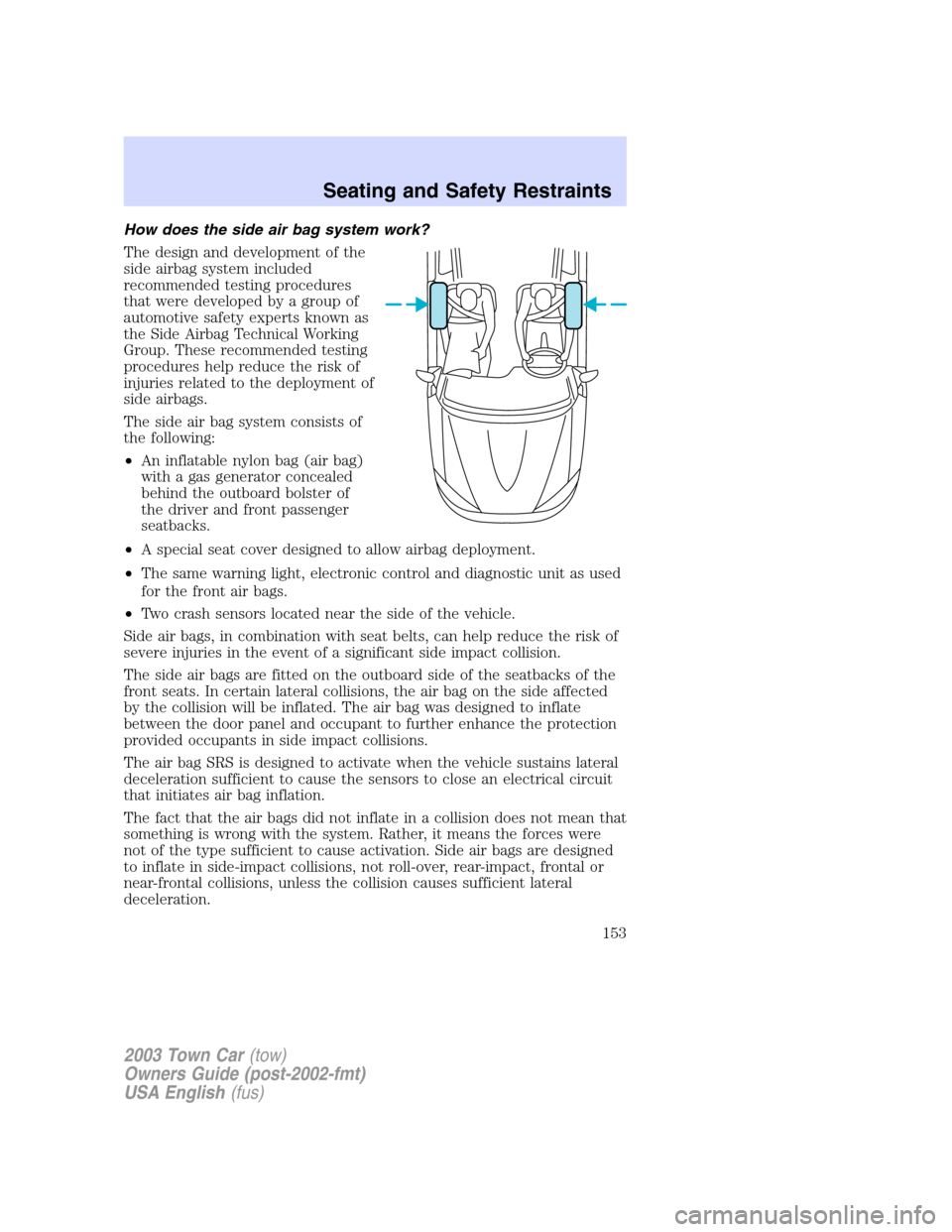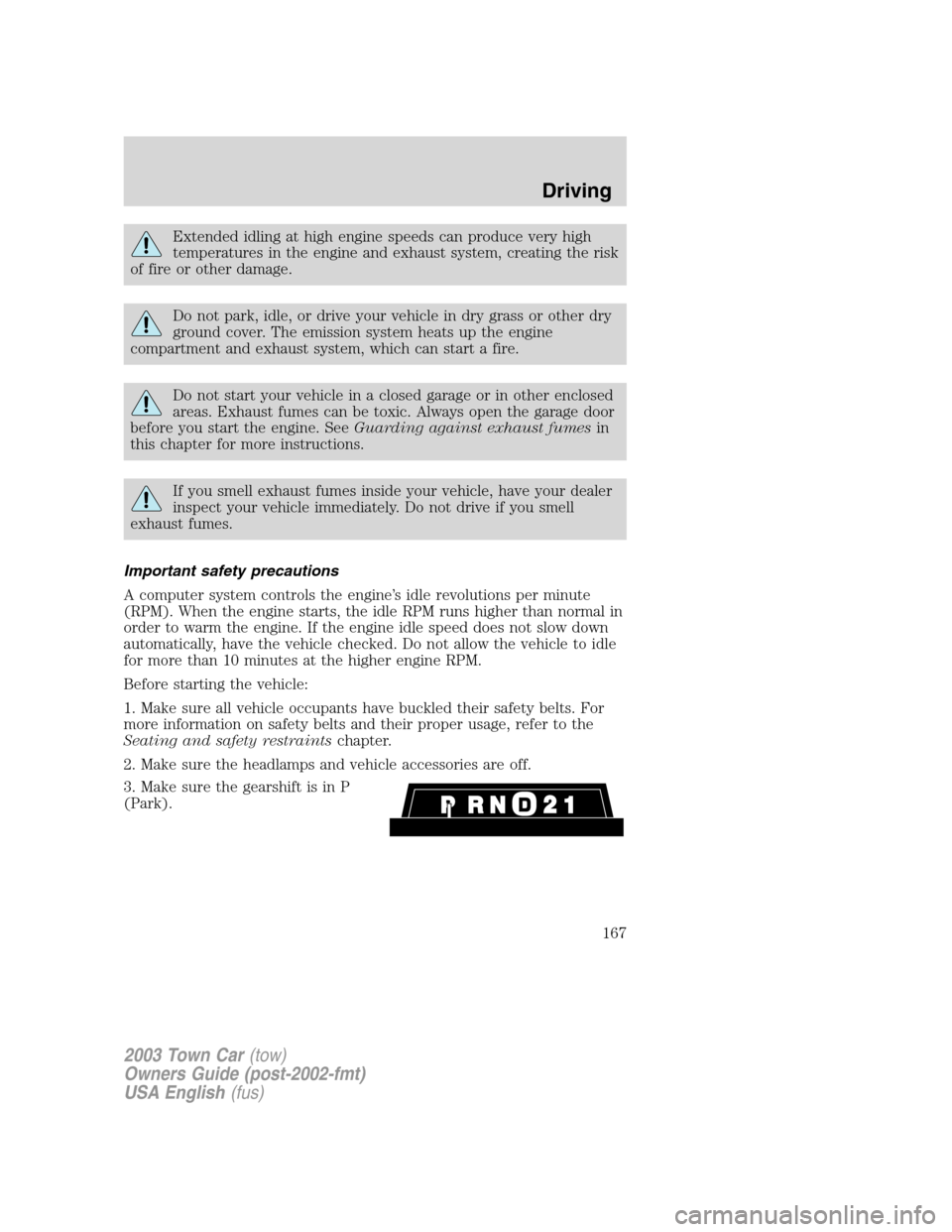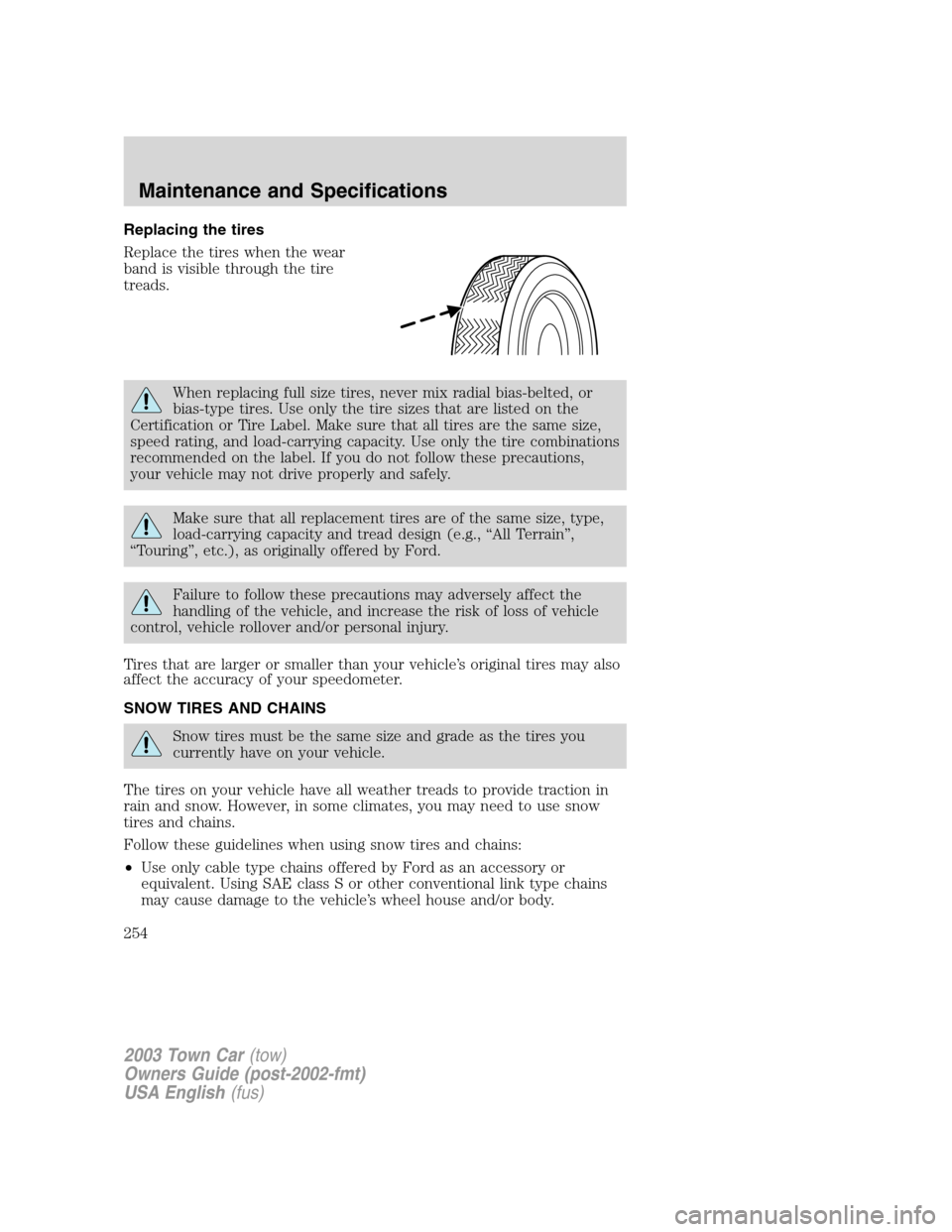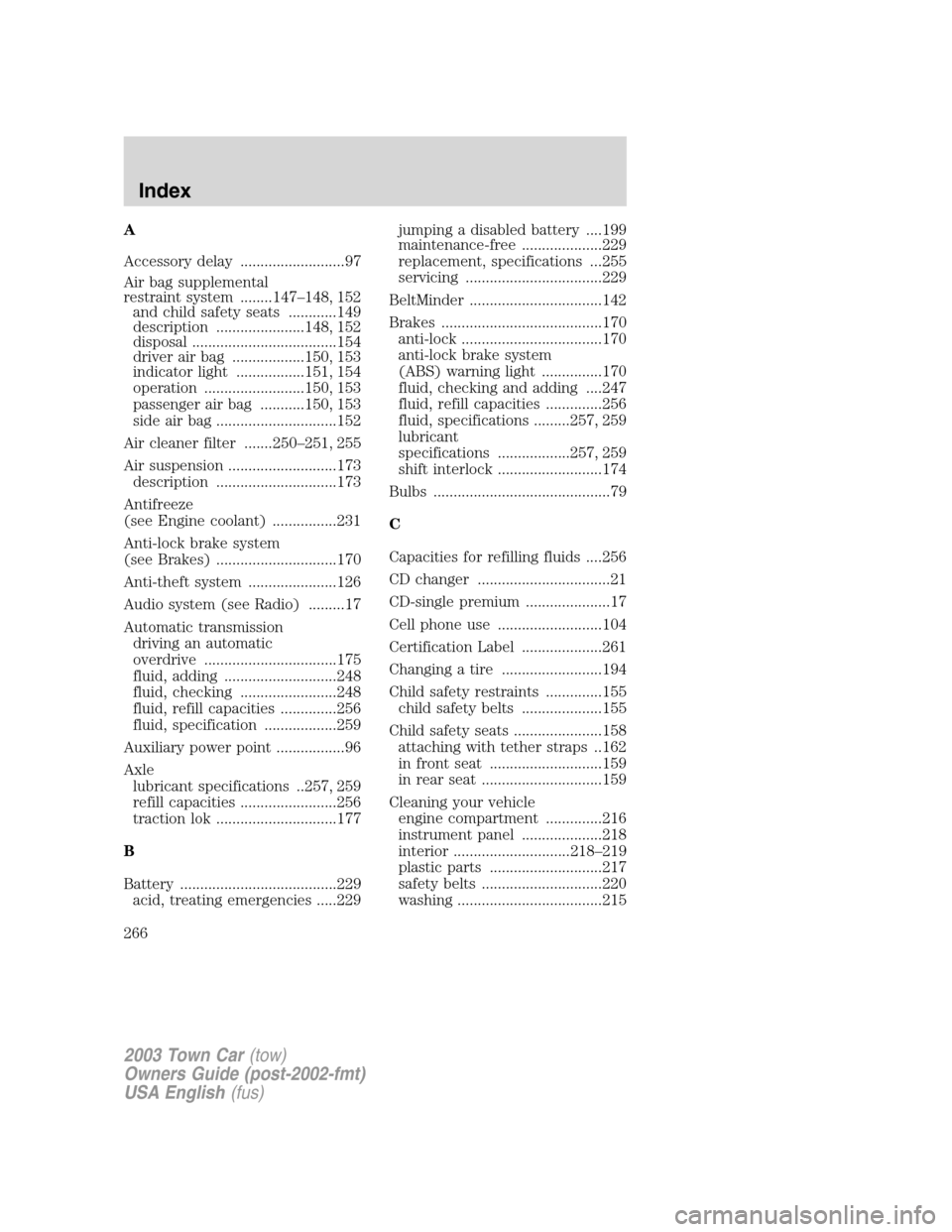Page 153 of 272

How does the side air bag system work?
The design and development of the
side airbag system included
recommended testing procedures
that were developed by a group of
automotive safety experts known as
the Side Airbag Technical Working
Group. These recommended testing
procedures help reduce the risk of
injuries related to the deployment of
side airbags.
The side air bag system consists of
the following:
•An inflatable nylon bag (air bag)
with a gas generator concealed
behind the outboard bolster of
the driver and front passenger
seatbacks.
•A special seat cover designed to allow airbag deployment.
•The same warning light, electronic control and diagnostic unit as used
for the front air bags.
•Two crash sensors located near the side of the vehicle.
Side air bags, in combination with seat belts, can help reduce the risk of
severe injuries in the event of a significant side impact collision.
The side air bags are fitted on the outboard side of the seatbacks of the
front seats. In certain lateral collisions, the air bag on the side affected
by the collision will be inflated. The air bag was designed to inflate
between the door panel and occupant to further enhance the protection
provided occupants in side impact collisions.
The air bag SRS is designed to activate when the vehicle sustains lateral
deceleration sufficient to cause the sensors to close an electrical circuit
that initiates air bag inflation.
The fact that the air bags did not inflate in a collision does not mean that
something is wrong with the system. Rather, it means the forces were
not of the type sufficient to cause activation. Side air bags are designed
to inflate in side-impact collisions, not roll-over, rear-impact, frontal or
near-frontal collisions, unless the collision causes sufficient lateral
deceleration.
2003 Town Car(tow)
Owners Guide (post-2002-fmt)
USA English(fus)
Seating and Safety Restraints
153
Page 167 of 272

Extended idling at high engine speeds can produce very high
temperatures in the engine and exhaust system, creating the risk
of fire or other damage.
Do not park, idle, or drive your vehicle in dry grass or other dry
ground cover. The emission system heats up the engine
compartment and exhaust system, which can start a fire.
Do not start your vehicle in a closed garage or in other enclosed
areas. Exhaust fumes can be toxic. Always open the garage door
before you start the engine. SeeGuarding against exhaust fumesin
this chapter for more instructions.
If you smell exhaust fumes inside your vehicle, have your dealer
inspect your vehicle immediately. Do not drive if you smell
exhaust fumes.
Important safety precautions
A computer system controls the engine’s idle revolutions per minute
(RPM). When the engine starts, the idle RPM runs higher than normal in
order to warm the engine. If the engine idle speed does not slow down
automatically, have the vehicle checked. Do not allow the vehicle to idle
for more than 10 minutes at the higher engine RPM.
Before starting the vehicle:
1. Make sure all vehicle occupants have buckled their safety belts. For
more information on safety belts and their proper usage, refer to the
Seating and safety restraintschapter.
2. Make sure the headlamps and vehicle accessories are off.
3. Make sure the gearshift is in P
(Park).
2003 Town Car(tow)
Owners Guide (post-2002-fmt)
USA English(fus)
Driving
167
Page 168 of 272
4. Make sure the parking brake is
set.
5. Turn the key to 4 (ON) without
turning the key to 5 (START).
Make sure the corresponding lights illuminate or illuminate briefly. If a
light fails to illuminate, have the vehicle serviced.
•If the driver’s safety belt is fastened, the
light may not illuminate.
HOOD
1
2
34
5
2003 Town Car(tow)
Owners Guide (post-2002-fmt)
USA English(fus)
Driving
168
Page 254 of 272

Replacing the tires
Replace the tires when the wear
band is visible through the tire
treads.
When replacing full size tires, never mix radial bias-belted, or
bias-type tires. Use only the tire sizes that are listed on the
Certification or Tire Label. Make sure that all tires are the same size,
speed rating, and load-carrying capacity. Use only the tire combinations
recommended on the label. If you do not follow these precautions,
your vehicle may not drive properly and safely.
Make sure that all replacement tires are of the same size, type,
load-carrying capacity and tread design (e.g.,“All Terrain”,
“Touring”, etc.), as originally offered by Ford.
Failure to follow these precautions may adversely affect the
handling of the vehicle, and increase the risk of loss of vehicle
control, vehicle rollover and/or personal injury.
Tires that are larger or smaller than your vehicle’s original tires may also
affect the accuracy of your speedometer.
SNOW TIRES AND CHAINS
Snow tires must be the same size and grade as the tires you
currently have on your vehicle.
The tires on your vehicle have all weather treads to provide traction in
rain and snow. However, in some climates, you may need to use snow
tires and chains.
Follow these guidelines when using snow tires and chains:
•Use only cable type chains offered by Ford as an accessory or
equivalent. Using SAE class S or other conventional link type chains
may cause damage to the vehicle’s wheel house and/or body.
2003 Town Car(tow)
Owners Guide (post-2002-fmt)
USA English(fus)
Maintenance and Specifications
254
Page 266 of 272

A
Accessory delay ..........................97
Air bag supplemental
restraint system ........147–148, 152
and child safety seats ............149
description ......................148, 152
disposal ....................................154
driver air bag ..................150, 153
indicator light .................151, 154
operation .........................150, 153
passenger air bag ...........150, 153
side air bag ..............................152
Air cleaner filter .......250–251, 255
Air suspension ...........................173
description ..............................173
Antifreeze
(see Engine coolant) ................231
Anti-lock brake system
(see Brakes) ..............................170
Anti-theft system ......................126
Audio system (see Radio) .........17
Automatic transmission
driving an automatic
overdrive .................................175
fluid, adding ............................248
fluid, checking ........................248
fluid, refill capacities ..............256
fluid, specification ..................259
Auxiliary power point .................96
Axle
lubricant specifications ..257, 259
refill capacities ........................256
traction lok ..............................177
B
Battery .......................................229
acid, treating emergencies .....229jumping a disabled battery ....199
maintenance-free ....................229
replacement, specifications ...255
servicing ..................................229
BeltMinder .................................142
Brakes ........................................170
anti-lock ...................................170
anti-lock brake system
(ABS) warning light ...............170
fluid, checking and adding ....247
fluid, refill capacities ..............256
fluid, specifications .........257, 259
lubricant
specifications ..................257, 259
shift interlock ..........................174
Bulbs ............................................79
C
Capacities for refilling fluids ....256
CD changer .................................21
CD-single premium .....................17
Cell phone use ..........................104
Certification Label ....................261
Changing a tire .........................194
Child safety restraints ..............155
child safety belts ....................155
Child safety seats ......................158
attaching with tether straps ..162
in front seat ............................159
in rear seat ..............................159
Cleaning your vehicle
engine compartment ..............216
instrument panel ....................218
interior .............................218–219
plastic parts ............................217
safety belts ..............................220
washing ....................................215
2003 Town Car(tow)
Owners Guide (post-2002-fmt)
USA English(fus)
Index
Index
266
Page:
< prev 1-8 9-16 17-24